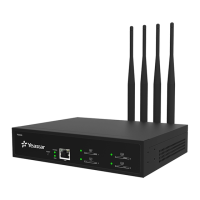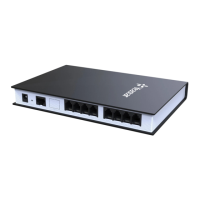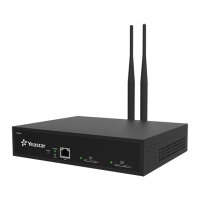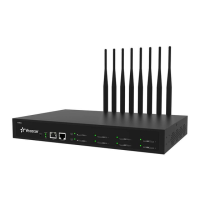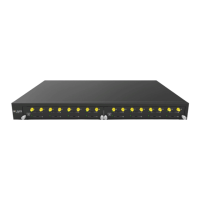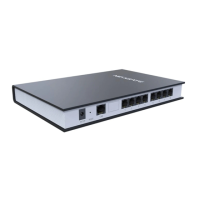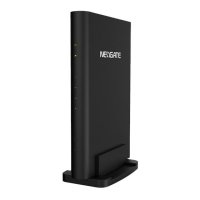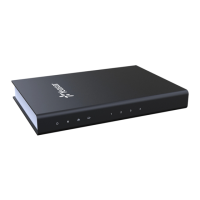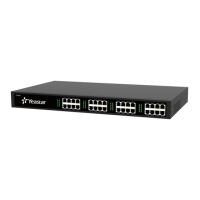Do you have a question about the Yeastar Technology TG100 and is the answer not in the manual?
| SIP Trunks | 1 |
|---|---|
| Concurrent Calls | 1 |
| LAN | 1 x 10/100 Mbps |
| Operating Temperature | 0°C to 40°C |
| Protocols | SIP (RFC3261) |
| Voice Codec | G.711 |
| Fax | T.38 |
| Power Supply | DC 12V |
| Humidity | 10% to 90% (non-condensing) |
Essential safety precautions to prevent electric shock and device damage during operation.
Describes the physical components and indicators on the front of the TG100 gateway.
Describes the physical components and indicators located on the back of the TG100 gateway.
Lists all items included in the TG100 package for initial setup.
Crucial safety information and warnings to prevent accidents during hardware installation.
Specifies the recommended environmental conditions for installing and operating the TG100 gateway.
Step-by-step instructions for correctly inserting and removing the SIM card from the device.
Guidance on how to connect the external antenna for optimal GSM/3G signal reception.
Instructions for connecting the TG100 gateway to the network using an Ethernet cable.
Steps to connect the power adapter and supply power to the TG100 gateway.
Procedures for accessing the TG100 gateway's web-based configuration interface.
Overview of the main sections and functionalities within the TG100 web configuration panel.
Steps to name and identify the mobile module, including setting the SIM card number.
Instructions on how to restart or reboot the device's mobile module via the web interface.
How to enable or disable the mobile module's functionality for making calls.
Guide to enable or disable the Caller Line Identification (CLIR) feature.
Settings to limit call durations or set monthly talk plans for mobile trunks.
Procedure to unlock a SIM card that has a PIN lock enabled.
Configure routing for mobile-to-IP calls when using account mode.
Configure routing for IP-to-mobile calls when using account mode.
Steps to connect the TG gateway to a PBX using the register trunk mode.
Configure mobile-to-IP call routing for register trunk mode.
Configure IP-to-mobile call routing for register trunk mode.
Steps to connect the TG gateway to a PBX using the peer trunk mode.
Configure mobile-to-IP call routing for peer trunk mode.
Configure IP-to-mobile call routing for peer trunk mode.
Configure rules to restrict specific numbers from making outgoing calls via the GSM/3G trunk.
Set up rules to block both incoming and outgoing calls for specified numbers.
Configure callback functionality for designated phone numbers.
Define rules for stripping or prepending digits for callback numbers.
Configure the gateway to automatically record failed outgoing calls for callback.
Remove recorded failed outgoing calls from the AutoCLIP table.
Guide on sending SMS messages through the TG gateway's web interface.
Create, manage, and organize contact lists for sending SMS messages.
View, search, download, and delete messages that have been sent.
Access and view incoming SMS messages received by the TG gateway.
Configure settings to automatically forward received SMS messages to an email address.
Configure settings to forward emails as SMS messages.
Procedures for sending USSD messages to GSM/3G carriers for service subscription.
Configure API settings for third-party software integration with the gateway.
Guide to changing the administrator password for the TG gateway's web interface.
Adjust the gateway's date, time, and time zone settings for accuracy.
Instructions for updating the TG gateway's firmware via HTTP or TFTP.
Methods for backing up and restoring system configurations and custom prompts.
How to restart the TG gateway appliance through the web interface.
Procedure to perform a factory reset, erasing all configurations.
Steps to modify the TG gateway's IP address for network compatibility.
Configure VLAN settings to integrate the gateway into a virtual LAN environment.
Establish a secure VPN connection using OpenVPN for remote access and data transfer.
Configure Dynamic DNS to access the gateway using a domain name.
Detailed steps for configuring static routes on the TG gateway.
Organize VoIP trunks into groups for efficient route configuration.
Adjust general SIP parameters for registration, codecs, and DTMF modes.
Detailed configuration of general SIP parameters like ports, registration time, and user agent.
Configure NAT settings to enable remote registration and VoIP calls.
Select and prioritize codecs for VoIP communication to optimize quality.
Set up Quality of Service parameters to prioritize voice traffic.
Customize SIP response codes for better PBX understanding.
Configure advanced SIP features including caller ID, ringing, and security options.
Configure settings for the Internal Asterisk Exchange (IAX) protocol.
Set global preferences for the TG gateway, such as ring timeout and echo cancellation.
Access and manage various security configurations and settings for the gateway.
Set up email or phone notifications for IP attacks and web login attempts.
Upload trusted and gateway certificates for secure TLS VoIP connections.
Create and manage firewall rules to protect the gateway from network attacks.
Steps to define and add new firewall rules for network traffic control.
Disable ping requests to enhance the gateway's security posture.
Configure firewall to block all incoming packets and connections except trusted ones.
Automatically add IPs to a blacklist based on packet count thresholds.
View the operational status of mobile and VoIP trunks.
Detailed status indicators for the mobile trunk, including signal strength.
Check the registration status of VoIP trunks configured with accounts.
Monitor the gateway's network connectivity, IP, and MAC address information.
Access detailed records of all calls made through the TG gateway.
Review system, hardware, debug, and web logs for troubleshooting.
Display and navigate through the call log entries on the interface.
Filter call logs based on various criteria like date, status, and trunk.
Export filtered call log data into a .csv file for analysis.
Enable and monitor hardware-specific log files for diagnostics.
Enable and monitor general system logs for operational tracking.
Enable and monitor debug logs, including SIP and RTP, for troubleshooting.
Download system log files for offline analysis and debugging.
Use the integrated tool to capture and analyze network packets for debugging.
